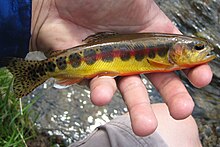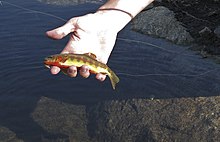User talk:Cullen328/Sandbox
Good stuff. I've got lots more here: www.thehighsierra.org Have a look and steal what you want. Bareflag (talk) 05:09, 18 August 2009 (UTC)
starting article on Chuck Pratt
Francis P. Farquhar Mountaineering Award[edit]
The Francis P. Farquhar Mountaineering Award is given by the Sierra Club, and is named after club leader, historian and mountaineer Francis P. Farquhar. According to the Sierra Club, this award "honors an individual's contribution to mountaineering and enhancement of the Club's prestige in this field". [1] It was first given in 1970.
Award winners [2]
- 1970 Norman Clyde and Allen Steck
- 1971 Richard Leonard
- 1972 Jules Eichorn
- 1973 Glen Dawson
- 1974 Nicholas Clinch and Marjorie Farquhar
- 1977 Galen Rowell
- 1978 John and Ruth Mendenhall
- 1979 William E. Siri
- 1981 Sam Fink
- 1982 Arlene Blum
- 1983 Steve Roper
- 1985 Richard Hechtel
- 1987 Lotte Kramer
- 1988 Gordon Benner
- 1994 Randy Dante and Doug Mantle
- 2001 Andrew J. Smatko
- 2003 Barbara Lilley
- 2005 Gerry Roach
Golden trout[edit]
The Golden trout (Oncorhynchus mykiss aguabonita), is a sub-species of the rainbow trout (Oncorhynchus mykiss). The fish is also known as the California golden trout and is native to Golden Trout Creek, Volcano Creek and the South Fork Kern River. Another variant, O. m. whitei, was historically found only in the Little Kern River but is now found in other nearby creeks, as well. The golden trout is commonly found at elevations of 10,000 ft (3,000 m) above sea level, and is native to California. Originally placed in the species Oncorhynchus aguabonita, most taxonomists now classify the golden trout as a subspecies of the rainbow trout, Oncorhynchus mykiss,[3][4] placing it with several other subspecies commonly known as redband trout, Oncorhynchus mykiss ssp.


The golden trout has golden flanks with a red, horizontal band along the lateral line and 10 dark oval marks, called "parr marks", on each side. Dorsal, lateral and anal fins have white leading edges. In their native habitat, adults range from 6–12 in (15–30 cm) long. Fish over 10 in (25 cm) are considered large. Golden trout that have been transplanted to lakes have been recorded up to 11 lb (5 kg) in weight. The world record golden trout was caught by Charles S. Reed, on August 5, 1948, from Cook Lake in the Wind River Range. That fish was 28 in (70 cm) long and weighed 11.25 lb (5.1 kg).[5] Preferred water temperature is 58–62 °F (14–17 °C).[citation needed]
Years of overexploitation, mismanagement and competition with exotic species have brought these fish to the brink of being designated as threatened. Introduced brook trout (Salvelinus fontinalis) outcompete them for food, introduced brown trout (Salmo trutta) prey on them and introduced rainbow trout (O. mykiss) hybridize with them, damaging the native gene pool through introgression.
The golden trout was designated the state fish of California in 1947. Populations have been in steady decline for decades. As a result, the California Department of Fish and Game [1] signed an agreement with federal agencies in September 2004 to work on restoring back-country habitat. Conservationists have also been attempting to introduce golden trout to other waters such as to Lake Mohave in Nevada and Arizona.
The golden trout should be distinguished from the similarly-named golden rainbow trout, also known as the palomino trout. The golden rainbow is actually a color variant of the rainbow trout.[6]
Chuck Yeager and the New Mexico population[edit]
Colonel Chuck Yeager introduced one of his commanding officers, General Irving "Twig" Branch, to the Sierra Nevada populations of golden trout, Branch ordered Yeager and Bud Anderson to introduce the species to the mountain streams of New Mexico, where they can be fished to this day.[7]
In his second autobiography, Press On, Yeager details his annual fishing trips to catch golden trout which he extols as one of the best game fish and best eating fish to be found.
California's offical state fish is the California golden trout. California has three distinct subspecies of rainbow trout commonly grouped as golden trout: Kern River rainbow trout, Little Kern golden trout, and California golden trout. Today Kern River rainbows are found in the Kern River between Durrwood Creek and Junction Meadow, though other transplanted populations exist. Little Kern golden trout are still found in their native habitat in the Little Kern River. California golden trout are found in their natal streams of Golden Trout creek and the South Fork Kern River and in addition have been transplanted to many other isolated lakes and locations for the purpose of sportfishing. Many of these transplanted golden trout hybridize with hatchery reared coastal rainbows. Native habitat for golden trout is primarily found at high elevations in meandering streams with little riparian vegetation. The water is generally clear and cold (3-22°C) and substrates are composed of cobble, gravel, and sand. Favorable reaches include pools that provide cover in the forms of undercut banks and aquatic vegetation. Individual golden trout tend to remain in a small stretch of stream measuring 16-18 m. Fish transplants have brought golden trout to lakes and streams they did not previously inhabit. Generally these new waters are at high elevations and may include stretches of stream above impassible fish barriers. Golden trout feed both day and night on a wide variety of items, especially aquatic insects. Cryptic coloration or a lack of predators may account for their feeding habits. Despite increased vulnerability to birds and mammals males develop especially bright colors during the breeding season. Golden trout may live up to 9 years, reaching 10-11 cm SL by the end of their third summer. Their growth rate slows to 1-2 cm/year thereafter and they may eventually reach 19-20 cm SL. Lake dwelling trout arriving via transplants grow more rapidly and reach greater maximum sizes. Golden trout reach sexual maturity in 3-4 years and spawn in late spring or early summer when water temperatures range from 10 to 15°C. Spawning peaks in the afternoon when water temperatures reach their daily maximum. Females dig wide shallow redds among small gravel particles and lay 300-2,300 eggs. The eggs hatch in approximately 20 days at 14°C. Emergent fry remain in the substrate for 2-3 weeks before rising into the main water column.
References[edit]
- ^ "Secriptions of Sierra Club National Awards". San Francisco: Sierra Club. Retrieved 15 February 2010.
- ^ Sierra Club Awards - List by Award
- ^ "Oncorhynchus aguabonita". Integrated Taxonomic Information System. 24 January.
{{cite web}}: Check date values in:|date=and|year=/|date=mismatch (help) - ^ Froese, Rainer; Pauly, Daniel (eds.) (2005). "Oncorhynchus aguabonita" in FishBase. 10 2005 version.
- ^ Wyoming Game and Fish Department (http://gf.state.wy.us/fish/fishing/stats/records/index.asp)
- ^ Journal of Applied Ichthyology, Volume 16 Issue 3 Page 117-120, June 2000(http://www.blackwell-synergy.com/doi/abs/10.1046/j.1439-0426.2000.00147.x)
- ^ Yeager, Chuck and Janos, Leo. Yeager: An Autobiography. Pages 348-351 (paperback). New York: Bantam Books, 1986. ISBN 0-553-25674-2.
UC Davis
Chuck Yeager and the New Mexico population…[edit]
… is totally the name of my next bluegrass band.
I'm so sorry to have wasted your time on this! I'm a n00b in Wikipedia, and I have awkward social skills at the best of times, and a dreadful sense of humour. (I also have very poor impulse control, on which I have done enormous amounts of work to train myself to be more aware of it when it's happening - hence my decision to post this comment, which seems counterintuitive until I tell you that when something *does* get through my web of manual impulse-screening skills, I figure it's probably earned its liberty!)
I don't even remember how to sign my name. Is it Charlie Sanders (talk) 04:57, 6 May 2018 (UTC) ? Well, I'm Charlie, anyway. Nice to meet you. Do you happen to play a mandolin, by any chance? I'm thinking about starting a bluegrass band. Charlie Sanders (talk) 04:57, 6 May 2018 (UTC)
